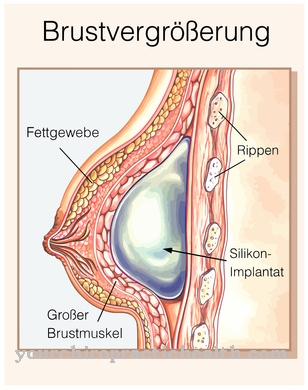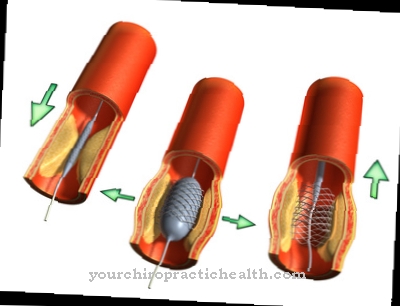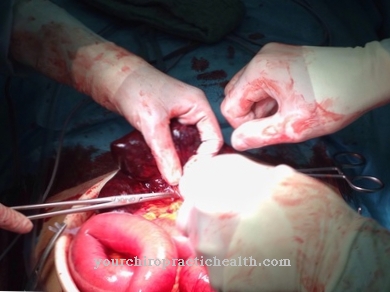The Redon drainage is a high vacuum drainage for sucking off wound secretion after massive surgical procedures. This is inserted into the actual operation in the operating area and withdrawn after about 3 days. This drain is placed on the bones, under muscle fascia and in the subcutaneous tissue.
What is the Redon Drainage?

The Redon drainage is a so-called Suction drainage or one High vacuum drainagewhich is often placed in the surgical field after invasive surgical operations. Usually, the Redon drainage is located within joints or below the fatty tissue.
The drainage system consists of a thick-walled drainage hose and a collecting container. The collecting container is under negative pressure and thus directs wound secretion and blood out of the operating area. Furthermore, the suction pulls the wound surfaces together, which enables the wound edges to grow together more quickly. Due to the negative pressure, the drainage contributes to serum prophylaxis or haematoma prophylaxis. Basically, the higher the pressure inside the drainage, the better the wound healing. The high vacuum drainage works with a suction of 900 mbar.
Depending on the amount of wound secretion drained, the Redon drainage is removed 48 - 72 hours postoperatively. The Redon drainage is available in different sizes with a controlled and an uncontrolled suction into the vacuum bottle. The drainage system is named after the Parisian oral surgeon Henry Redon.
Function, effect & goals
If the Redon drainage is correctly placed in a closed operating area, it is called a closed system. Through the continuous and controlled suction, the wound fluid and the blood are drained to the outside.
The end of the drain, which is inserted within the operating area, consists of a thin plastic tube that is perforated several times. The creation of several openings at the end of the tube in order to be able to suck off more secretion is called perforated.The plastic tube is fixed to the tissue with a small seam at the transition from the internal to the external area. A plastic bottle is attached to the external end to collect the wound secretion. The drainage is attached to the vacuum bottle with a bayonet lock.
The constant negative pressure inside the drainage leads to a continuous suction of the wound secretion. The negative pressure within the vacuum bottle decreases after a certain time. To restore this, the vacuum bottle must be replaced. Basically, the wound cavity must be sealed airtight in order to insert a functioning high vacuum drainage system.
The high vacuum drains are usually inserted after invasive surgical interventions and are important for the postoperative healing process. By sucking off the wound fluid, the wound healing is accelerated because the wound cavity is thereby reduced. The wound edges are pulled together and can scar or grow together more quickly. No Redon drainage is placed during surgical interventions in the abdominal cavity, as this can damage the intestinal wall. The drain is usually removed after 48-72 hours postoperatively. If several high vacuum drains have to be inserted, these must be labeled and the amount of secretion documented differently.
The vacuum bottle must be completely checked and recorded. If the bottle is full or the valve indicates that there is no longer any vacuum in the bottle, it must be replaced. The exchange must be carried out under aspetic conditions. Before the new bottle is connected to the drainage tube, it should be checked that the vacuum formation is intact and that the bottle is undamaged and sterile. To change the bottle and to reconnect the drainage hose, a thorough hand disinfection should be carried out before and after. The actual implementation takes place with sterile gloves.
The high vacuum drain is removed after about 3 days to avoid the risk of ascending infection. Before removing the drainage, the patient can be given a pain reliever as this can be uncomfortable or painful. Before pulling, the sterile dressing must first be removed and the drainage outlet must be disinfected. The attending physician can then hold the drainage tube and ask the patient to breathe in and out deeply. The hose can be pulled during exhalation. Finally, the wound is cleaned again and bandaged with sterile bandages.
Risks, side effects & dangers
The rednospit can cause injury during surgery. Often, skin nerves within joints are damaged. Access from the outside to the inside via the Redon drain increases the risk of infection and germs can form within the operating area. In addition, the drainage can be pulled out completely or incompletely. This often happens in restless, demented, and mentally confused patients. The Redon drainage can also slip when the patient is repositioned or mobilized.
Increased blood loss via the high vacuum drainage can occur. The reason for this is often the incorrect position of the drainage within the cancellous bone. The vacuum bottle must be examined at regular intervals and the values recorded. Occasionally, the drainage tube can become clogged with detached tissue structures, thrombi, clotted blood, and protein and fat components. If the drainage is disturbed, an infected hematoma can result from the build-up of wound secretion.
In order to ensure good drainage, care should always be taken to ensure that the hose is not kinked and that the patient does not lie on the plastic hose. The function of the Redon drainage should therefore be checked regularly to prevent possible complications.




.jpg)






















